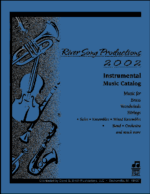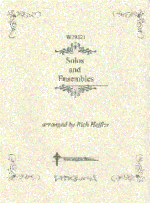-
-
-
-
-
-
-
-
-
-
I Know Whom I Have Believed
$14.95This has hints of a Joplin rag – a unique arrangement from Rich Heffler (arr. For the Marine Band). This same title is available as a solo, or as a woodwind trio from the Rich Heffler Library.
This woodwind quintet version of Rich’s popular setting -
At The Cross
$14.95Rich Heffler wrote a series of quintets – this one includes piano accompaniment – to be performed at Camp of the Woods in upper New York state. This camp is one of the finest facilities of Christian camping in the country, with a full orchestra playing most
-
Were You There?
$14.95Rich Heffler has arranged this traditional Spiritual in a contemporary setting, with some classical rhythmic elements – one of his trademarks. The five parts are for a traditional woodwind quintet – but substitute parts are included so flute, clarinet
-
Jesus Paid It All
$14.95This is the first woodwind quintet from a series written by Rich Heffler (Marine Band arranger) for a professional church woodwind ensemble, performing concerts. This title was first played at Camp of the Woods in upper New York state – a Christian c
-
Open My Eyes
$14.95This true woodwind quintet has the Rich Heffler signature on it. Using idioms from Brahms’ Symphony no. 2, first movement, (and actual musical portions), Rich has woven an arrangement around the Brahms musical ideas and the hymn tune that will deligh
-
It Is Well With My Soul
$14.95This is probably Rich Heffler’s best selling title – and is very well received in both traditional and contemporary worship services, and at many Christian schools. Rich has created some very unique and classic rhythmic patterns in the accompaniment,
-
Medley Of Nine Hymn Favorites
$14.95This arrangement includes all or part of nine favorite hymn tunes and gospel songs found in most hymnals. Each title is well known by many and is a reminiscent collection of tunes. The arrangement includes parts for many instrumentalists and can be used by woodwinds, strings or a mixture of both.
-
Song Without Words
$11.95Original, impressionistic composition that musically represents the classic “Peace of God.” Excellent for preludes or weddings.
-
Fairest Lord Jesus/I Surrender
$11.95This medley of two hymns is composed in a Mozartian style. The slow moving lines add to the elegance of the ornamentation. Flexible instrumentation is provided so that this composition may be played by a variety of instrument combinations.
-
Variations On Joy To The World
$11.95This arrangement was created for many instrumental combinations in the Rich Heffler tradition. Rich is an arranger for the U.S. Marine Band and creates ensembles that include some classical traditions as part of the setting. Different instruments c
-
To God Be The Glory/O Worship The King
$11.95Another Rich Heffler arrangement performed at the National Conventions of the CIDA (Christian Instrumentalists and Directors Association). Rich is an official arranger for the US Marine Band, and this setting shows his mastery of including classical
-
And Can It Be/It Is Well
$11.95Medley in a fugue style. All three parts of equal difficulty, and no part dominates the other. Professionals love this style.
-
-
Minuet II
$12.95This arrangement has been played at the Christian Instrumental Director’s National Conference by as many as 30 players. The setting comes with parts for all families of woodwinds. It is a true trio in form, but can be performed by many players in a


